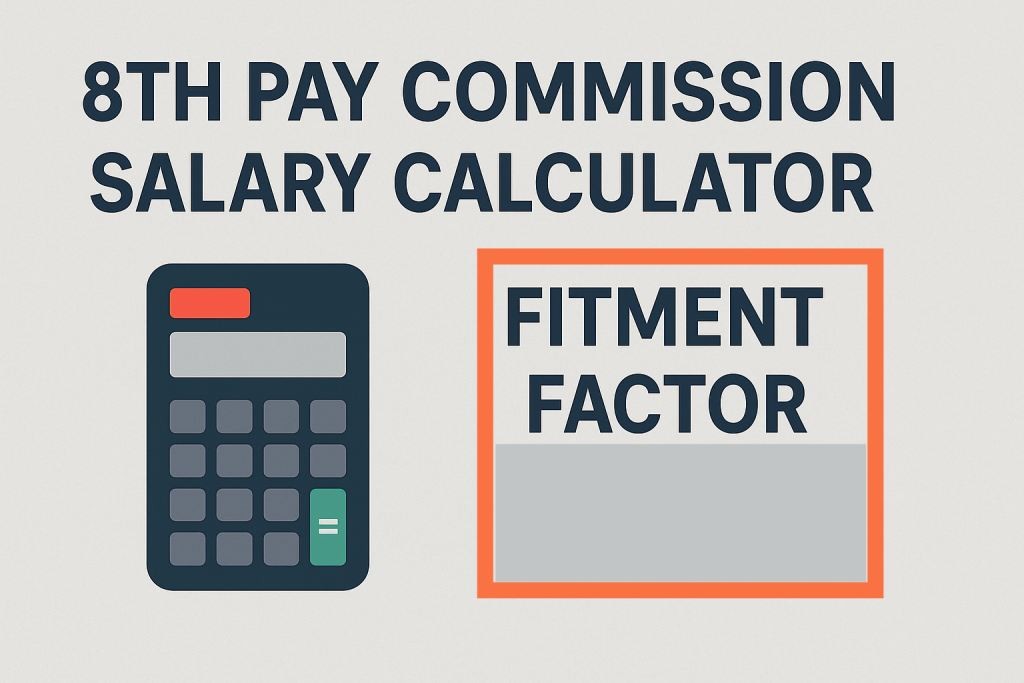This Post Contents
8th CPC Salary Calculator (Tentative)
Estimate your revised salary under the 8th Pay Commission (expected 2026). Select your details below.
8th Pay Commission Salary Calculator - Overview
Calculate your estimated salary under the upcoming 8th Pay Commission, expected to be implemented in 2026. This tool helps central government employees, including faculty and other staff, estimate their revised salaries based on tentative fitment factors (1.92 to 3.0), Dearness Allowance (DA), House Rent Allowance (HRA), Travel Allowance (TA), and deductions like NPS and CGHS. Simply select your pay level, basic pay, city type, and other parameters to get a detailed salary breakdown.
Key Features:
- Supports both GP (General Pay) and AGP (Academic Grade Pay) for faculty.
- Includes HRA based on city classification (X, Y, Z cities).
- Accounts for tentative DA percentages (0% to 100%).
- Estimates tax under the New Tax Regime FY 2025-26.
- Provides a detailed breakdown of gross and net salary.
Use this calculator to plan your finances and understand the potential impact of the 8th Pay Commission on your salary.
Frequently Asked Questions (FAQs)
What is the 8th Pay Commission?
The 8th Pay Commission is the anticipated revision of salary structures for central government employees, expected to be implemented in 2026. It will replace the 7th Pay Commission and adjust salaries, allowances, and pensions based on economic factors.
What is the fitment factor in the 8th Pay Commission?
The fitment factor is a multiplier applied to the basic pay to calculate the revised salary under the 8th Pay Commission. This calculator offers tentative factors (2.28, 2.57, 2.86, 3.0) based on historical trends and projections.
How is HRA calculated?
House Rent Allowance (HRA) is calculated as a percentage of the revised basic pay, depending on the city type: 27% for X cities (population > 50 lakh), 18% for Y cities (5–50 lakh), and 9% for Z cities (< 5 lakh).
What is the New Tax Regime FY 2025-26?
The New Tax Regime for FY 2025-26, as per the budget dated Feb 01, 2025, offers simplified tax slabs with no exemptions. This calculator uses these slabs to estimate monthly tax deductions.
Can I adjust NPS contributions?
Yes, the calculator allows you to manually enter NPS contributions. By default, it assumes 10% of (Basic Pay + DA), but you can override this value.
Rules for Using the 8th Pay Commission Salary Calculator
- Accurate Inputs: Select the correct pay level (GP for non-faculty, AGP for faculty) and basic pay to ensure accurate calculations.
- City Classification: Choose the appropriate city type for HRA and TA, as rates vary based on population (X, Y, Z cities).
- Fitment Factor: The default fitment factor is 2.86, but you can select other values (2.28, 2.57, 3.0) for different scenarios.
- DA Percentage: Select a DA percentage based on expected rates. The default is 70%, reflecting current projections.
- Deductions: Enter NPS and CGHS contributions accurately. Other deductions (e.g., LIC, loans) are not included but can be manually accounted for in financial planning.
- Tax Estimation: Taxes are calculated based on the New Tax Regime FY 2025-26. Results are estimates and may vary due to additional income or policy changes.
- Limitations: This calculator provides tentative estimates. Actual salaries will depend on official 8th Pay Commission announcements.
Understanding the 8th Pay Commission and Your Salary
The 8th Pay Commission is a highly anticipated event for central government employees and pensioners in India, expected to bring significant revisions to their salary structure, allowances, and pensions. While an official calculator is yet to be released, information available from various sources allows for projections and understanding of how the new pay scales might be calculated.
Key Highlights and Latest Updates on the 8th Pay Commission:
- Approval and Implementation: The government has approved the 8th Central Pay Commission, with implementation expected from January 1, 2026.
- Beneficiaries: It will impact over one crore central government employees and pensioners.
- Purpose: The primary objective is to revise compensation and welfare policies in line with current economic conditions, inflation trends, and the growing demands of central government employees.
Understanding the 8th Pay Commission Salary Calculation:
The overall salary hike under the 8th Pay Commission will primarily depend on the fitment factor, which is a multiplier applied to an employee's current basic pay to arrive at the new basic pay. Other components like Dearness Allowance (DA), House Rent Allowance (HRA), and Travel Allowance (TA) will then be calculated based on this revised basic pay.
Here's a breakdown of the key components and their expected impact:
-
Fitment Factor:
- This is the most crucial element determining the salary hike.
- While the official fitment factor is yet to be announced, various reports and expert opinions suggest a range:
- Some sources project it to be around 2.28 to 2.86.
- Others indicate a possible 3.00, which could lead to a 34.1% hike in minimum pay.
- There are also discussions around a 1.92x fitment factor in conservative scenarios.
- For comparison, the 7th Pay Commission had a fitment factor of 2.57.
- A higher fitment factor means a higher increase in the overall basic salary.
-
Revised Basic Pay:
- The new basic pay will be calculated by multiplying the current basic pay (as per the 7th Pay Commission) by the fitment factor.
- Formula: $$ \text{Revised Basic Pay} = \text{Current Basic Pay} \times \text{Fitment Factor} $$
- For example, if the current minimum basic pay is ₹18,000 and the fitment factor is 2.28, the new minimum basic pay could be approximately ₹41,040. If it's 3.00, it could be ₹21,600 (as per some reports based on a proposed 34.1% hike in minimum pay). Other reports indicate it could go up to ₹41,000 to ₹51,480.
-
Dearness Allowance (DA):
- DA is provided to offset the impact of inflation and is usually revised twice a year (January and July).
- A significant change expected under the 8th Pay Commission is the merger of the accumulated DA with the basic salary at the time of implementation. This means future DA hikes will start from a zero base on the new, higher basic pay.
- The DA is expected to reach around 70% by early 2026 before being merged.
- Formula (after merger, for future DA calculations): $$ \text{DA} = \text{Revised Basic Pay} \times \text{DA Percentage (starting from 0% after merger)} $$
-
House Rent Allowance (HRA):
- HRA is a component of salary given to employees for their accommodation needs.
- It is calculated as a percentage of the basic pay and varies based on the city classification (X, Y, Z cities).
- Current (7th CPC) HRA Slabs:
- X Class Cities (population $\geq$ 50 lakh): 24% of Basic Pay
- Y Class Cities (population 5-50 lakh): 16% of Basic Pay
- Z Class Cities (population $<$ 5 lakh): 8% of Basic Pay
- These percentages are subject to revision under the 8th Pay Commission. Some reports suggest HRA rates may be kept higher in metro cities.
- Formula: $$ \text{HRA} = \text{Revised Basic Pay} \times \text{City Percentage} $$
-
Travel Allowance (TA):
- TA is provided to cover commuting expenses.
- It typically depends on the employee's pay level and the city of posting (higher for big cities).
- The 8th Pay Commission is expected to revise TA rates. Some reports suggest TA calculation may be different for employees in rural or semi-urban areas.
-
Gross Salary Calculation:
- Once the revised basic pay, DA, HRA, and TA are determined, the gross salary can be estimated.
- Formula (simplified): $$ \text{Gross Salary} = \text{Revised Basic Pay} + \text{DA} + \text{HRA} + \text{TA} - \text{Standard Deduction (if applicable)} $$
- It's important to note that other allowances (like Children Education Allowance, Dress Allowance, etc.) and deductions (like NPS contribution, CGHS charges) will also be revised.
Example of a Simplified 8th Pay Commission Salary Calculation (Based on a proposed Fitment Factor of 3.00 for illustration, actual factors may vary):
Let's assume:
- Current Basic Pay (7th CPC): ₹18,000 (Minimum Pay Level 1)
- Proposed Fitment Factor: 3.00
- DA (after merger with basic pay, starting from 0%): 0% initially for future calculations
- HRA for X-Class City: 27% (as per some proposed rates)
- TA (for Level 1-2 in big cities): ₹1,350 + DA thereon (using the 7th CPC rates as a placeholder, actual 8th CPC TA rates will be announced)
Steps to Calculate Gross Salary:
-
Revised Basic Pay:
₹18,000 $\times$ 3.00 = ₹54,000
-
Dearness Allowance (DA):
Initially, upon implementation, DA is expected to merge with basic pay, so future DA calculation starts from 0% of the new basic pay. For illustrative purposes, if DA were 0% after merger:
₹54,000 $\times$ 0% = ₹0
-
House Rent Allowance (HRA):
₹54,000 $\times$ 27% = ₹14,580
-
Travel Allowance (TA):
Assuming the 7th CPC rate of ₹1,350 + DA thereon for Level 1-2 in big cities. If DA is merged, the 'DA thereon' part will need clarification in the 8th CPC rules. For simplicity, let's assume a fixed amount of ₹1,350 for now, knowing it will be revised.
₹1,350
-
Gross Salary:
₹54,000 (Revised Basic Pay) + ₹0 (DA) + ₹14,580 (HRA) + ₹1,350 (TA) = ₹69,930
Important Considerations and Caveats:
- Official Announcements: The figures and formulas provided above are based on current reports and expectations. The final official recommendations and implementation rules of the 8th Pay Commission may differ.
- Terms of Reference (ToR): The specific terms of reference for the 8th Pay Commission are yet to be fully released, which will outline the scope of their work.
- Delay in Formation: There have been some concerns about delays in the formation of the commission itself, which could potentially push the implementation beyond the expected January 2026 date.
- Fiscal Implications: The government will consider the fiscal implications of any proposed hikes, and the final fitment factor and allowance rates will balance employee demands with the government's financial capacity.
- Pensioners: Pensioners are also expected to benefit significantly from the 8th Pay Commission, with revisions in Dearness Relief (DR) and minimum pension amounts.
Central government employees and pensioners are advised to stay updated with official announcements from the government regarding the 8th Pay Commission to get the most accurate information on their revised salaries and benefits.


